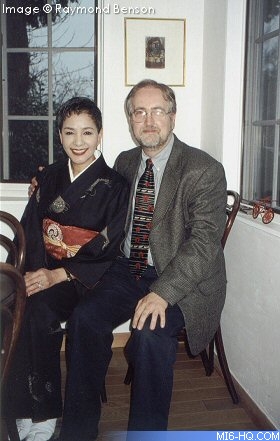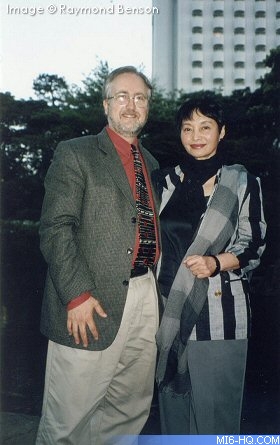|
|
|
Opinion - And Twice Is The Only Way To Live!
(1)
13th June 2007
In the first part of the special "And Twice Is The
Only Way To Live" series, James Bond novelist Raymond Benson
reflects on You Only Live Twice...
When I first saw You Only Live
Twice in 1967, I was a very impressionable
eleven years old (and would turn twelve two months later). I
had, of course, already seen the first four James Bond films
in the cinema, as well as the abominable rival 007 picture, Casino
Royale (which totally befuddled me at the time, but that’s
a different story). For a warm-blooded American boy my age, YOLT
was the best thing since, well, the last Bond film, and as I
left the theater I can remember thinking it was the best Bond
film. I was blown away by the spectacular "bigness" of
the film, the ultra-cool gadgets, the beautiful musical score,
the science fiction plotline, and the exotic mystery of the Japanese
locales. In hindsight, I certainly don't think it's the best
Bond film by any means—and I came to this conclusion not
long after seeing it for the first time—but I do feel that
it's one of the best, a picture that I'd list in my favorite
top ten.
By the time the film was released, I had read the Ian
Fleming books. This occurred within the previous two
years, when I was between the ages of nine and eleven.
Not a small feat for a boy that young, especially in a
social environment in
which the Fleming novels were considered "racy" by the day’s
standards. And much of the text most likely went right over my head, too—but
I was able to comprehend the stories, get a handle on who the literary Bond was
(although in my mind he was Sean Connery), and appreciate the class act that
Ian Fleming demonstrated. Thus, I was familiar with the novel
entitled You Only
Live Twice. When I walked into the movie theater with my father and sister
to see the film, I was expecting a Garden of Death, a Japanese medieval castle,
and the death of Ernest Stavro Blofeld. (I also remember being puzzled why OHMSS was
not appearing prior to YOLT. How could they make YOLT without making OHMSS first?)
But once the picture started and the gun-barrel iris opened on a space capsule,
I was hooked. (Looking back, the special effects were pretty poor, but one must
bear in mind that the film was released prior to 2001: A Space Odyssey, the picture
that changed the way we looked at visual effects in film.)
|
|
 |
By 1967, the Spy Boom had already reached its zenith and was on a slow decline.
As a result of the Bond series' success, the Gods of Pop Culture decided that
spies and high-tech "gee-whiz, that's cool!" toys were going to be
the dominating elements of mass market entertainment. It seemed that there were
a zillion Bond knock-offs—some good and some simply awful—on film
and on television. Thunderball, at the end of
1965, had been big, spectacular, and a high quality (and high grossing) picture.
The Flints, UNCLEs, Matt Helms,
and Harry Palmers were okay, but nothing compared to number one—James Bond.
Nobody did it better. Even though the Spy Boom had begun to wane when YOLT finally
made it to the theaters, the new EON production brought it all back, at least
for the summer. The producers threw into YOLT everything you could possibly imagine
that might be associated with the "fantasy-spy pop culture business." (It's
important to distinguish the difference between what we saw in movies and on
television from the reality of the Cold War and the gritty world of genuine espionage.
There was nothing glamorous about the latter.) In YOLT, we had perhaps the most
exotic location imaginable (Japan, a country about which the West knew very little),
the biggest proliferation of spy toys, an entire lineup of gorgeous Japanese
girls, a couple of great fight sequences, unusual chases, and huge set pieces.
It's no wonder that Mike Myers would primarily draw upon YOLT for inspiration
when he made his Austin Powers films. The 1967 film epitomized the apex
of
swinging,
ultra-cool spy movies.
 Above: Raymond Benson with Mie Hama
at her home in 2001
Above: Raymond Benson with Mie Hama
at her home in 2001 |
|
As for the film itself, there are some who might say that
it is totally unrealistic, smothered in an improbable science
fiction sensibility, and presented way over the top. It is.
In fact, this would be the case for almost all the Bond adventures
made between 1967 and 1979, with the exception of OHMSS. John
Brosnan, in his excellent book James Bond in the Cinema, points
out that YOLT is really a bigger-budget remake of Dr
No. A bad guy lives in a remote, hidden lair, is paid
to play havoc with the space program, and tries to create
an international conflict. It's astonishing how frequently
the EON producers returned to this premise when developing
future works. Structurally, at least, The
Spy Who Loved Me is almost a blow by blow remake of YOLT.
The only differences are that the story involves the sea instead
of outer space, the locations have changed, and the tones
are decidedly dissimilar. And therein lies the rub. YOLT's
atmosphere—that is, the way the movie feels—is
akin to the earlier pictures. In other words, it takes itself
seriously as a Bond film. It is definitely a part of the continuity
established by the first four Connery movies. Even though
the plot is unbelievable, the situations are impossible, and
overall the film is not as good as the previous entries, YOLT
wants us to suspend our disbelief and go along for the ride.
|
The Bond flicks of the 1970s do not do this.
It is my contention that the 1970s entries are really parodies
of the 1960s Bond pictures—not as extreme as, say, the Austin
Powers movies, but parodies nonetheless. The Roger Moore efforts
played everything for laughs—they were send-ups because
the producers must have felt that the audience could not take
a Bond picture seriously anymore. Everything in these later movies
had a wink and a nudge-nudge attached. But with YOLT, this isn't
the case. It's played straight. It's exciting, entertaining, and
suspenseful, and you actually care whether or not Bond is going
to stop World War III. And that's why, in my opinion, YOLT is
better than TSWLM, or any of the other 1970s productions.
Some of my favorite moments-
-
The fight with the Sumo in the office.
FANTASTIC! One of the best fights in any Bond film.
-
The arrival in Japan—the sights,
the sounds, the music... gorgeous!
-
Aki. A wonderful Bond-girl.
-
Little Nellie. Ranks as one of the
best Bond gadgets ever. So cool, so cool.
-
Arguably Maurice Binder's best main
title sequence.
-
One of the best three Bond scores
by John Barry.
-
And although it's a rather ho-hum
performance, the film stars Sean Connery as Bond,
when he still *looked* like Bond!
-
Ingenious assassination method (that
fails to kill Bond but does murder Aki).
-
Gorgeous cinematography and locations.
-
Ken Adam's best set ever—the
volcano. A masterpiece of design.
|
A postscript—In 2001, when I was
in Japan researching my novel The Man With the Red Tattoo,
I had the great pleasure of meeting the two main actresses
from the film—Akiko
Wakabayashi and Mie Hama.
In fact, Mie Hama served dinner to me and my friends in
her home. What a treat! Both ladies are still beautiful
and very gracious. It was a highlight of all my Bond experiences.
This opportunity alone will keep YOLT in my memory as a
beloved entry in the Bond film canon.
For anyone interested, I have listed my
top ten favorite Bond movies in order of preference (with
a runner-up) on Amazon.com.
- Raymond Benson, 2007
Raymond Benson was the official author of James
Bond continuation novels between 1996 and 2002. He
wrote six original 007 novels, three film novelizations,
and three short stories during his tenure. He is also
the author of the original suspense novels Sweetie’s
Diamonds (now available in mass market paperback), Face
Blind, and Evil Hours. Writing as “David Michaels,” he
is also the author of the best-selling Tom Clancy’s
Splinter Cell and Tom Clancy’s Splinter Cell—Operation
Barracuda. Check out his official site at www.raymondbenson.com
Right: Raymond Benson with Akiko Wakabayashi
in 2001. |
|
 |
The
views of this columnist and those expressed in this article are
not necessarily those of mi6-hq.com or its owners.
Related Articles
 You
Only Live Twice - 40th Anniversary You
Only Live Twice - 40th Anniversary
|
|
|